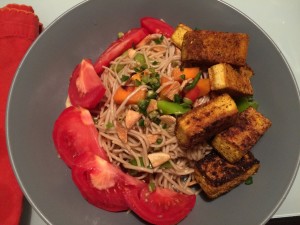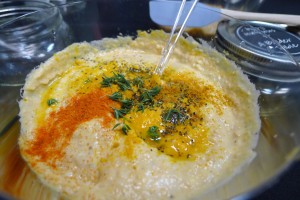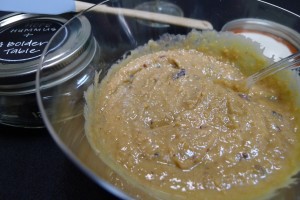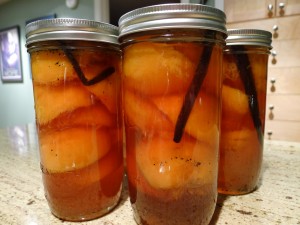Vietnamese Sweet Lemon Curry Soba Noodle Tofu Salad
- At September 10, 2016
- By megan
- In carrot, curry, Farm to Table, favorites, garlic, local foods, noodles, Recipes, Savory Spice Shop, tofu, tomatoes
 0
0
If I’m going to enjoy tofu, it HAS to have been frozen, thawed, and pressed before being seasoned and cooked. Freezing tofu changes the texture into something I almost find enjoyable, so there’s always a block sitting in our freezer. This cold soba noodle salad with tofu, locally grown carrots, peppers, and tomatoes, and fried garlic is well worth repeating.

Here’s how I made it.
First, the thawed tofu needs to be pressed to expel excess liquid. I usually wrap it in a few layers of paper towels and gently squeeze it, being careful not to squeeze too hard and tear the block. Then it’s ready to be cut into bite-sized pieces and marinated. I chose a dry rub since it was going to be fried. Wet marinades make for quite a mess when it hits hot oil. Lesson learned!
The tofu was generously seasoned with Vietnamese Sweet Lemon Curry from Savory Spice Shop and then pan fried in peanut oil until crispy on all sides. The secret to getting a nice crust on each side is having a hot pan, hot oil, and not checking the food to see if it’s cooked, but waiting until it’s fully seared before flipping it. The chef-husband had to lecture me a few times on this before I listened, and what a difference it makes! Gone (hopefully) are the days of tofu sticking to the pan and breaking apart when it’s flipped, leaving smaller pieces to burn and stripping the tofu of it’s coating (read: flavor). After each side gets a crust, just remove them and let them cool.
Next, a chopped carrot and green pepper from the Boulder Farmer’s Market went into the peanut oil pan to heat them ever so slightly. I boiled soba noodles according to the instructions on the package and then rinsed them in cold water to keep them from cooking, fried some garlic until crispy, chopped a jalapeño, and sliced a tomato.
I tossed the cold noodles with sesame seeds and the carrot and pepper pieces, and then drizzled some toasted sesame seed oil, fresh squeezed lemon, soy sauce (I prefer the unpasteurized Nama Shoyu brand), and a little local honey. Finally, I added diced jalapeño and crispy fried garlic for an extra crunch and kick.
I HOPE Hummus
- At July 24, 2016
- By megan
- In appetizer, Boulder Farmers Market, curry, favorites, Hummus, local foods, snack
 0
0
I was invited to visit Hope Foods, maker of the incredibly fresh and delicious Hope Hummus, in Louisville, Colorado. I’ve seen the name around for a few years now, but I can’t recall ever purchasing one of their products before. I knew that they started selling hummus at the Boulder County Farmers Market, and I knew they’d expanded and were on shelves in a number of our local grocers, but that’s the most I could have told you before last week. Now I could talk your ear off about what a great local company they are and how Hope Hummus should be your hummus of choice if you’re not making it from scratch at home. It will certainly be my go-to when I’m not following Chef Mike Solomonov’s recipe, which is a very traditional Israeli hummus. In fact, I was so inspired by my visit to Hope Foods that I’ll likely tweak chef Solomonov’s recipe the next time I make it.
~Inspiration to create new flavors of garbanzo bean spread~ That’s what came to me on our media party at Hope Foods. We were given two bowls of hummus, a “regular” or savory one and a sweet one that was sweetened with agave syrup. There was a table of ingredients full of spices, herbs, jams, nut butters, pumpkin, roasted peppers, lemons, limes, coconut flakes, goji berries…you name it and it was likely on a table for us to mix our own flavored hummus.

I added pumpkin puree, curry powder, cayenne pepper, turmeric powder, lemon juice, fresh thyme and ground black pepper to my savory bowl. Then mixed it all together and scooped it into a Ball jar labeled for A Bolder Table, which was a nice touch 🙂
Next up was the sweet hummus, which I wasn’t really sure what I’d enjoy, so I kept it simple: Almond butter and blackberry jam.

This combination would go really well on toast, and I would have NEVER thought of sweetening hummus on my own, so I’m inspired to try a variety of combinations in the future.
After mixing up some unique spreads, we were given a tour of the 15,000 square foot hummus factory, and learned that Hope Foods doesn’t make a ton of hummus and store it until an order comes in. They make hummus to order, so there’s a two day turn-around time from when they make the hummus to when it’s loaded on a truck for delivery. That’s FRESH in my opinion. It’s also Cold Pressure Prepped, which means it needs neither preservatives nor high heat to ensure each batch is safe from pathogens, bacteria, and mold. Another important detail that sets them apart from their competitors is adding olive oil rather than canola oil to their hummus. In short, Hope Foods makes fresh hummus using as few ingredients as they can without skimping on ingredient quality to produce a large quantity of food. I can stand behind that.
An operation that started with a group of friends making hummus in a commissary kitchen and selling it at the farmers market now employs 30+ people and makes more than ten different flavors of hummus. In my opinion, this company is doing everything right, and I am proud to have them as a local producer here in Colorado. I hope they continue to spread good things.
Local Turkey makes for a Bolder Thanksgiving
- At October 25, 2015
- By megan
- In Farm to Table, local foods, thanksgiving, turkey
 0
0
We LOVE sourcing local ingredients, and are so excited to have reserved a turkey with Long Shadow Farm in Berthoud, CO. We had one last year and it was phenomenal! Serving a fresh bird that had never been frozen was an absolute highlight to the gorgeous meal Sean and I prepared for some clients and their family. We can’t wait to do it again!
There’s a very limited supply of birds, so reserve one now.
Palisade Peaches in Vanilla Bean Syrup
- At August 27, 2015
- By megan
- In Boulder Farmers Market, local foods, peach, Recipes, Sean Smith, vanilla
 0
0
August is here and Palisade Peaches are in their prime. Last year Chef Sean made some vanilla bean syrup for his canned peaches, and they were some of our FAVORITE jars to open in the winter. Looks like we’ve now started a yearly tradition.
These peaches are pretty easy to make. This post here isn’t the place to learn the basics of canning, so be sure to familiarize yourself with sterilizing jars, water baths, etc. if you’ve never canned before. I also don’t have ratios and proper measurements… it’s more of an idea for you home canners to try.
First, Sean made a vanilla bean syrup by boiling equal parts sugar and water with a couple vanilla beans that he sliced in half long-ways and scraped out the beautiful caviar-like black beads. He let this reduce and cool completely.
Next, the peaches were blanched, which means boiled for a few minutes and then plunged into an ice bath. This allows the skins to be easily removed.
When cool to the touch, he sliced them in half and removed the pits, stacked them in jars, covered them in syrup, and processed them in a water bath for 15-20 minutes. After removing the jars from the boiling water, set them somewhere and allow them to cool. You’ll hear the pop of the lids after a little while, letting you know they’re properly sealed. Store in a cool place until winter.
Enjoy!

Let’s get Social